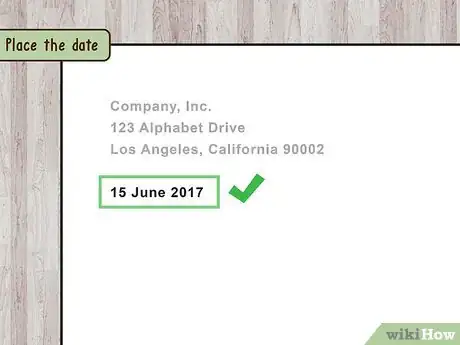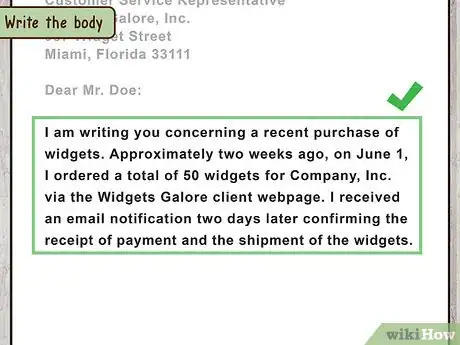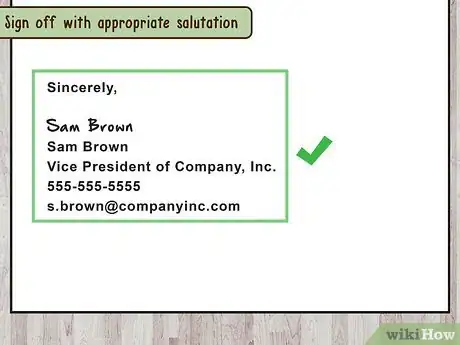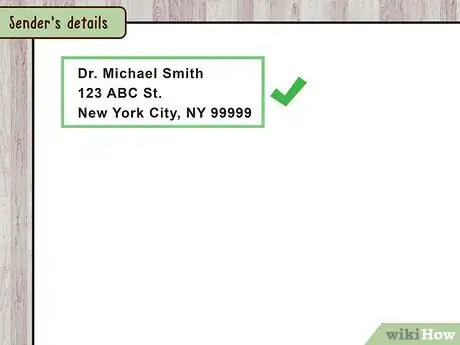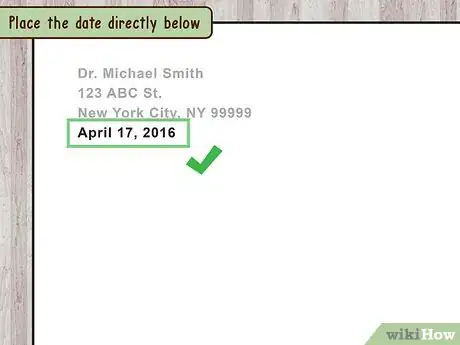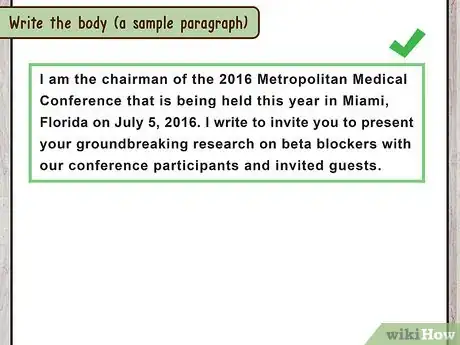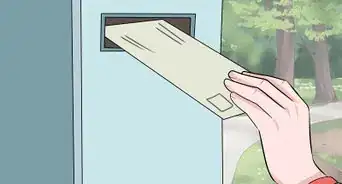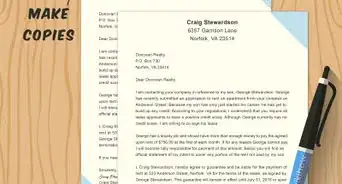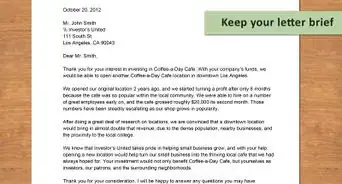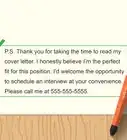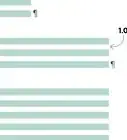This article was co-authored by Shannon O'Brien, MA, EdM and by wikiHow staff writer, Aly Rusciano. Shannon O'Brien is the Founder and Principal Advisor of Whole U. (a career and life strategy consultancy based in Boston, MA). Through advising, workshops and e-learning Whole U. empowers people to pursue their life's work and live a balanced, purposeful life. Shannon has been ranked as the #1 Career Coach and #1 Life Coach in Boston, MA by Yelp reviewers. She has been featured on Boston.com, Boldfacers, and the UR Business Network. She received a Master's of Technology, Innovation, & Education from Harvard University.
wikiHow marks an article as reader-approved once it receives enough positive feedback. This article has 51 testimonials from our readers, earning it our reader-approved status.
This article has been viewed 8,336,034 times.
Formal letters can come in handy when you need to communicate professionally. Maybe you’re emailing your boss about an upcoming vacation, confirming an appointment, asking for references, or resigning. No matter the case, a well-formatted formal letter can help you correspond with your boss or coworkers in an authoritative and organized manner. In the business world, there are 2 main types of formal letters: block style and Administrative Management Style (AMS). Block style is most widely known, while AMS is for quick internal memos; however, both styles are good to have in your tool belt.
Things You Should Know
- Block style letters include your address, the date, the recipient’s address, and an opening and closing salutations.
- AMS style letters also have your address, the date, and the recipient’s address, but they include an all-caps subject line instead of a salutation.
- Always use a positive tone throughout your letter that clearly states your wants, needs, or actions.[1]
Steps
Sample Letters
Block Style Letter
-
1Put your address and phone number in the top left-hand corner. If you’re representing a company, write the company’s address. If you’re the sender, write your address. Place your street address on the second line and your city, state, and zip code on the third. Include your phone number directly below your address.[2]
-
2Write the date a line below the sender's address. The date is important because it shows when the letter was written. Place the date 2 in (5.1 cm) from the top of the page a line after your address.[3]
- If you live in the United States, write your date as June 15, 2017.
- If you live in a European country, write your date as 15 June 2017.
Advertisement -
3Put the recipient’s name beneath the date. Skip a line and write out the recipient's name. Include the sender’s title (Mr., Mrs., Ms., Miss, Dr., etc.) before their name for formality.[4] Follow the recipient’s name with their job title, then write the name of their company or business below it. Write out the address the same way you printed yours at the top of the page.[5]
- If you don’t know the recipient’s title, do some background research or call the company.
-
4Greet the recipient with a polite salutation. Start your letter with a greeting like “Dear” to directly and formally address the recipient. Then, write out the recipient’s name again (including their title), and place a colon after the greeting to introduce the body of your letter.[6]
- Only use the greeting “To whom it may concern” as a last resort if you don’t know the recipient’s name or title.
- If you typically address the recipient by their first name, it’s okay to address them as such in your letter.
-
5Compose the body of the letter. Keep your letter clear, concise, and polite. Write in a formal tone and include at least 2 paragraphs about 5 sentences long that explain the purpose of your letter. Use a single space left-aligned format throughout, using the enter key to divide each paragraph.[7]
- In the first paragraph, start with a friendly opening that briefly states the reasoning or goal of your letter.[8]
- “I am writing to confirm our arrangements for Sunday, March 26th in the Plaza Hotel at 6 PM. As we discussed, I will have the necessary paperwork on hand, along with additional information you may need. I believe this partnership will benefit both of our companies…”
- In the second paragraph, use examples to stress or underline your points if necessary, especially if you’re persuading someone.
- “Since we last spoke, the Baking It website has gained over 50% more traffic and earned 11% more income through ads and affiliate links. Combining our expertise will certainly help us grow even more…”
- In the final paragraph, summarize your purpose for writing again and suggest how you might want to proceed.
- “I have enclosed the initial deposit and will forward the remaining amount by Monday, March 27th, our agreed-upon date. I cannot thank you enough for supporting my business endeavors, and I look forward to working with you. Please reach out at (555)888-9000 if you have any questions…”
- In the first paragraph, start with a friendly opening that briefly states the reasoning or goal of your letter.[8]
-
6Sign your letter with a formal goodbye. Close with “Sincerely,” “Thank you,” or “Best,” followed by your full name. Place any other contact information below your name, including your job title, phone number, and email address.
- If you’re printing your letter, leave enough space between your goodbye and printed name to physically sign your name.
- If you’re emailing your letter, digitally sign the document.
-
7Add an enclosure to the bottom of the document if you’ve attached materials. If you’re sending other documents or paperwork along with your letter, note how many documents are enclosed. Write “Enclosure:” along with the number of items below your signature.[9]
AMS Style Letter
-
1Write your address in the top left-hand corner. AMS letter format has been around since the 1950s and uses a full-block form and open punctuation. Put your business’s name, along with your street address, in the top left-hand corner.[10]
- If you’re using a letterhead, you don’t need to put the sender’s address. Instead, begin the letter with the date in the top left corner.
-
2Place the date directly below your address. Don’t leave a blank line between the sender’s address and date, as this is one of the ways an AMS style letter differs from the traditional block style.[11]
-
3Write the recipient’s address a line below the date. Skip a line after the date and list the recipient's name, company, and address. Keep this left aligned as well.[12]
-
4Include an all-caps subject line. One main difference between an AMS style letter and other formats is that it includes a subject line, like an email. Summarize your letter in one line or sentence, put the title in all caps, and place it directly under the recipient’s address.[13]
- For instance, your subject line could be something like, “YOU’RE INVITED TO METROPOLITAN MEDICAL CONFERENCE” or “YOUR PRESENCE IS REQUESTED IN TOWN SQUARE.”
- If you’re sending your letter via email, make sure to also include a non-caps subject line in the email’s title field, even if it conveys the same message.
-
5Put together the body of your letter. As with any formal letter, keep the body of your letter short, simple, and to the point.[14] Express what you need or want from the recipient right away, detail any information that may be necessary to prove your points, and then provide a solution or call for action.
- Introduce your reason for writing them in the first paragraph.
- “On behalf of the University of Tennessee’s Arts Department, we would like to invite you and your family to a benefit banquet on Saturday, March 25th at the Tennessee Performing Arts Center. Your contribution to the theatre has not gone unnoticed, and we’d like to honor you as a leading Fine Arts professor…”
- Explain any further details or points in your second paragraph.
- “As my resume indicates, I have hands-on experience working in the culinary field. I am have managed ten kitchens while implementing dining room customs and design changes…”
- Use a formal and polite tone while discussing your topic, even if your letter addresses an unfortunate circumstance.[15]
- Introduce your reason for writing them in the first paragraph.
-
6Sign your name at the bottom of your letter. Unlike traditional letters, a formal AMS letter does not include a salutation before or after the body paragraphs. So, once you’ve finished the body paragraphs, print your name and job title in closing.[16]
- Leave enough space for a physical or digital signature.
-
7Add any enclosures. Enclosures are extra materials sent with your letter. Write the word “Enclosure” below your signature, and then list the names of the enclosed materials. Only do this if you have other materials attached with the letter.[17]
Sending a Letter
-
1Pick out an envelope. Opt for an envelope that’s plain and either square or rectangular. While brightly colored envelopes can be fun, they may not be the best idea for a formal letter (remember, you mean business). So, avoid ones with patterns or designs.
-
2Fold your letter so it fits inside your envelope. A double or triple fold may be needed to fit your letter snuggly. Do your best to make the folds even.[18]
- If you’re using a standard rectangular envelope, fold your letter in horizontal thirds.
- If you’re using a square envelope, fold your letter in half horizontally and then in half vertically, so it forms a rectangle.
- Try only folding your letter once, as a letter with too many creases could make your envelope bulky and more difficult to mail.
-
3Place the letter inside the envelope. Seal the envelope shut by licking along the seal line or peeling off the strips covering the sticky part of the seal. This will depend on the type of envelope you have.[19]
- If you don’t like licking envelopes, no worries! Use some tape to seal it shut.
-
4Write your name and address in the top left-hand corner. Putting a return address on your envelope is very important because it’ll tell mail carriers where to bring the letter if it doesn’t reach its destination. Put your name and street address in the top left corner on the front of the envelope (the side without a flap).[20]
-
5Put the recipient’s address in the center of the envelope. Use the same address you used when writing your letter. Write the recipient’s name and address on the front center of the envelope in neat handwriting. If you’re sending the letter to a specific company, put the company’s name below the recipient’s name and above their address.[21]
-
6Stick a stamp (or 2) in the envelope's upper right corner. In order to mail your letter, you need to pay for postage. Stamps are the easiest way to do this. Simply place a stamp in the right corner, across from your address, and you’re good to go![22]
- Typically, it costs $0.63 to mail a standard letter first class.
- One stamp generally equals $0.63, but if your envelope is heavier than 1 oz of paper, it may need 1 or 2 stamps to cover the cost.
- If you’re unsure how many stamps to use, head to your local post office to weigh your envelope.
Expert Q&A
-
QuestionHow do I start the address on a formal letter?
 Shannon O'Brien, MA, EdMShannon O'Brien is the Founder and Principal Advisor of Whole U. (a career and life strategy consultancy based in Boston, MA). Through advising, workshops and e-learning Whole U. empowers people to pursue their life's work and live a balanced, purposeful life. Shannon has been ranked as the #1 Career Coach and #1 Life Coach in Boston, MA by Yelp reviewers. She has been featured on Boston.com, Boldfacers, and the UR Business Network. She received a Master's of Technology, Innovation, & Education from Harvard University.
Shannon O'Brien, MA, EdMShannon O'Brien is the Founder and Principal Advisor of Whole U. (a career and life strategy consultancy based in Boston, MA). Through advising, workshops and e-learning Whole U. empowers people to pursue their life's work and live a balanced, purposeful life. Shannon has been ranked as the #1 Career Coach and #1 Life Coach in Boston, MA by Yelp reviewers. She has been featured on Boston.com, Boldfacers, and the UR Business Network. She received a Master's of Technology, Innovation, & Education from Harvard University.
Career Coach Always call the person by their title if you know it. If you can, do some research to find out what their titles are so you address them properly.
Always call the person by their title if you know it. If you can, do some research to find out what their titles are so you address them properly. -
QuestionWhat are the correct page size and margins for a formal letter?
 wikiHow Staff EditorThis answer was written by one of our trained team of researchers who validated it for accuracy and comprehensiveness.
wikiHow Staff EditorThis answer was written by one of our trained team of researchers who validated it for accuracy and comprehensiveness.
Staff Answer wikiHow Staff EditorStaff AnswerUse 1 inch margins and standard letter or printer paper that's 8.5 inches by 11 inches.
wikiHow Staff EditorStaff AnswerUse 1 inch margins and standard letter or printer paper that's 8.5 inches by 11 inches. -
QuestionHow do I write a formal letter to a government official?
 wikiHow Staff EditorThis answer was written by one of our trained team of researchers who validated it for accuracy and comprehensiveness.
wikiHow Staff EditorThis answer was written by one of our trained team of researchers who validated it for accuracy and comprehensiveness.
Staff Answer wikiHow Staff EditorStaff AnswerFollow the advice and format above, but make sure to address the letter to the government official you wish to write. Some officials state how to send them mail on their websites, so check that before heading to the mailbox.
wikiHow Staff EditorStaff AnswerFollow the advice and format above, but make sure to address the letter to the government official you wish to write. Some officials state how to send them mail on their websites, so check that before heading to the mailbox.
References
- ↑ Shannon O'Brien, MA, EdM. Life & Career Coach. Expert Interview. 25 May 2021.
- ↑ https://www.sjsu.edu/writingcenter/docs/handouts/Resignation%20Letters.pdf
- ↑ https://owl.purdue.edu/owl/subject_specific_writing/professional_technical_writing/basic_business_letters/index.html
- ↑ Shannon O'Brien, MA, EdM. Life & Career Coach. Expert Interview. 25 May 2021.
- ↑ https://www.sjsu.edu/writingcenter/docs/handouts/Resignation%20Letters.pdf
- ↑ Shannon O'Brien, MA, EdM. Life & Career Coach. Expert Interview. 25 May 2021.
- ↑ https://www.apa.org/advocacy/guide/sample-letters.pdf
- ↑ Shannon O'Brien, MA, EdM. Life & Career Coach. Expert Interview. 25 May 2021.
- ↑ https://owl.purdue.edu/owl/subject_specific_writing/professional_technical_writing/basic_business_letters/index.html
- ↑ http://www.zeepedia.com/read.php?the_appearance_and_design_of_business_messages_punctuation_styles_business_communication&b=72&c=17
- ↑ http://www.zeepedia.com/read.php?the_appearance_and_design_of_business_messages_punctuation_styles_business_communication&b=72&c=17
- ↑ http://www.zeepedia.com/read.php?the_appearance_and_design_of_business_messages_punctuation_styles_business_communication&b=72&c=17
- ↑ http://www.zeepedia.com/read.php?the_appearance_and_design_of_business_messages_punctuation_styles_business_communication&b=72&c=17
- ↑ Shannon O'Brien, MA, EdM. Life & Career Coach. Expert Interview. 25 May 2021.
- ↑ Shannon O'Brien, MA, EdM. Life & Career Coach. Expert Interview. 25 May 2021.
- ↑ http://www.zeepedia.com/read.php?the_appearance_and_design_of_business_messages_punctuation_styles_business_communication&b=72&c=17
- ↑ https://owl.purdue.edu/owl/subject_specific_writing/professional_technical_writing/basic_business_letters/index.html
- ↑ https://www.usps.com/ship/letters.htm
- ↑ https://www.usps.com/ship/letters.htm
- ↑ https://www.usps.com/ship/letters.htm
- ↑ https://www.usps.com/ship/letters.htm
- ↑ https://www.usps.com/ship/letters.htm
- ↑ https://www.sjsu.edu/writingcenter/docs/handouts/Resignation%20Letters.pdf
About This Article
To write a formal letter, start in the top left corner. Write the sender's name or business, then write their address on the next line and their phone number one line below that. Skip one line, then write the date out, like "November 16th, 2015." Skip another line, then write the recipients name, job title, and address on their own respective lines. Skip another line, then write the body paragraph of your letter, which should be no more than 3 paragraphs. When you're ready to sign off, include your name, job title, and contact information, as well as space for you to sign. If you're enclosing other materials with the letter, put "Enclosure" at the bottom of the page, followed by the name of the documents enclosed. For more information about writing formal and direct memos, continue reading!





